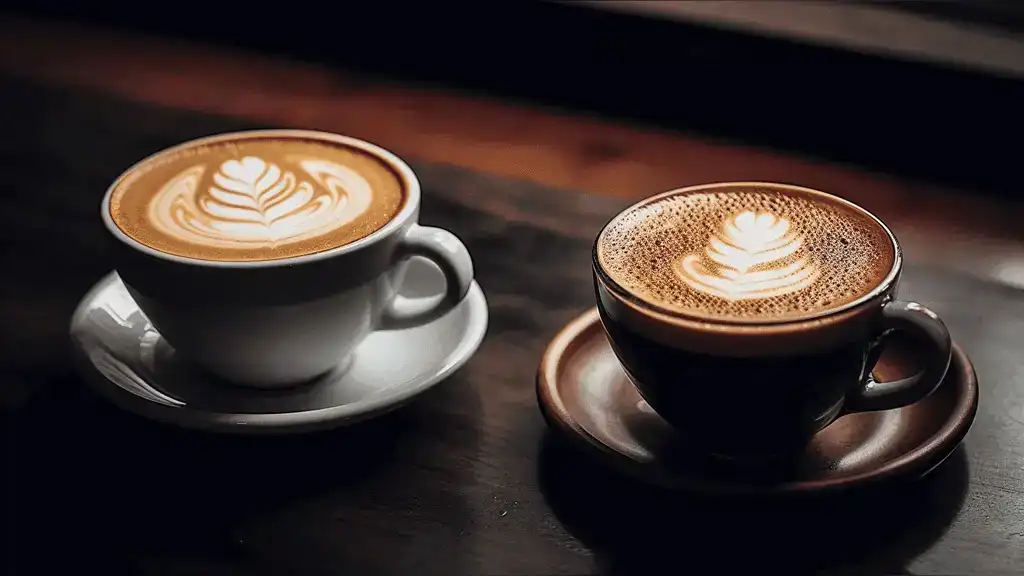What’s the difference between a wet and dry latte? Most people would say that a wet latte has more milk, while a dry latte has less. But there’s more to it than that.
In this blog post, we’ll explore the differences between wet and dry lattes, and what makes each one unique. So sit back, relax, and enjoy your cup of coffee!
what is a dry latte?
A dry latte is a variation of a traditional latte that uses foam instead of steamed milk, resulting in a lighter texture and a stronger espresso flavor.
This type of espresso shot uses less water, resulting in a stronger and more concentrated flavor. Additionally, if you prefer steamed milk, less steamed milk is added to a dry latte compared to a regular latte, giving it a lighter texture and sweeter taste.
While some coffee aficionados may prefer the bolder taste of a dry latte, others may find the lack of creamy foam and stronger espresso flavor too intense.
How to make a dry latte?
To make a dry latte, baristas will first pull a shot of espresso and then add one or two layers of foam on top. The result is a creamy and frothy drink, with an added layer of depth from the foam’s slight sweetness.
Dry lattes can also be made with alternative milk options, such as oat or almond milk, for those who need dairy-free options.
Here are the instructions on how to make a dry latte:
- Pull a shot of espresso using your espresso machine or a stovetop espresso maker.
- Heat and froth the milk of your choice (whole milk, skim milk, or a dairy-free option like oat or almond milk) until you have a thick layer of microfoam, as dry lattes have more foam than regular lattes.
- Create the perfect layering by pouring the espresso shot into your latte glass or cup.
- Gently pour the frothed milk into the espresso, holding back the foam with a spoon to let the milk flow first.
- Finish by spooning the remaining foam on top of the milk.
- Optionally, you can enhance the flavor by sprinkling some cocoa powder, cinnamon, or nutmeg on top.
Your dry latte is now ready to enjoy, with its creamy and frothy texture and the added depth of flavor from the foam. Enjoy your homemade dry latte!
What is a bone dry latte?
Have you heard the term “bone dry latte” and wondered what it means? A bone dry latte is a trendy new way to enjoy your coffee.
Traditionally, lattes are made with steamed milk, providing a creamy and smooth texture. A bone dry latte is made without any steamed milk at all. Instead, it uses extra shots of espresso to create a stronger and bolder flavor.
This coffee drink can also be called a “lazy latte” or an “evil twin.”
Is a dry latte a cappuccino?
Dry latte is not a cappuccino; they are distinct coffee beverages with different ratios of espresso, steamed milk, and foam.
It’s a common misconception that a dry latte and cappuccino are the same, but this simply isn’t true.
A cappuccino consists of equal parts espresso, steamed milk, and foam on top, while a latte has more steamed milk and less foam.
A dry latte is just a variation of a regular latte with less steamed milk and more foam.
While they may look similar in appearance, the two drinks have very different flavor profiles and preparation methods.
The dry latte is not the same as a cappuccino – it’s just another type of latte. It’s important to know the difference so you can order exactly what you want at your local coffee shop. Don’t let anyone fool you into thinking otherwise!
| Aspect | Dry Latte | Cappuccino |
|---|---|---|
| Composition | More foam, less steamed milk | Equal parts espresso, steamed milk, and foam |
| Appearance | Similar in appearance to a latte | Noticeably more foam on top |
| Flavor Profile | Creamy with prominent foam | Strong espresso flavor with creamy texture |
| Preparation Method | Espresso, steamed milk, more foam | Espresso, equal parts milk, foam |
| Common Misconception | Often mistaken for a cappuccino | Distinct from a dry latte |
What is a wet latte?
Wet latte is a latte made with extra steamed milk, resulting in a creamier and milder coffee drink.
This creates a creamier texture and dilutes the coffee somewhat, making for a milder drink. It is popular among those who prefer a less intense coffee flavor and those who like to add flavoring syrups to their drink.
How to Make Wet Latte?
To make a wet latte, steam extra milk, add espresso, and pour it into a cup, creating a drink with a layer of foam on top.
The resulting drink has a layer of foam on top, similar to that found on cappuccinos and other frothy coffee drinks.
While not as common as regular lattes or cappuccinos, wet lattes are still readily available at many coffee shops and can be easily customized with flavors or alternative milk.
To make a delicious wet latte, follow these steps:
- Brew a strong shot of espresso, typically using one or two shots.
- Pour about 6 ounces (180 ml) of cold milk into a frothing pitcher. You can use any milk of your choice.
- Froth the milk until it reaches a velvety, microfoam consistency (around 150°F or 65°C).
- Pour the espresso into a cup.
- Gently pour the frothed milk over the espresso, creating a latte art pattern if desired.
- Optionally, add sweeteners like sugar or flavored syrups to taste (e.g., vanilla, caramel, hazelnut).
- Stir if you’ve added sweeteners.
- Enjoy your homemade wet latte with its signature layer of foam on top!
Wet lattes are a delightful combination of espresso and creamy, foamy milk that can be customized with flavors or alternative milk to suit your preferences.
wet latte vs flat white
In the world of coffee, there can be a lot of confusion about the differences between drinks. One major point of contention is the difference between a wet latte and a flat white.
A wet latte, also known as a latte macchiato, starts with steamed milk and ends with a small amount of espresso poured on top. A flat white, on the other hand, includes equal parts steamed milk and espresso throughout the drink.
Both drinks have frothy milk and a similar level of caffeine, but the key difference is in the ratio of milk to espresso.
What is a skinny wet latte?
A skinny wet latte is a type of espresso drink that uses skim milk and has extra water added to it.
This combination creates a lower-calorie beverage with a thinner texture. Some coffee aficionados prefer the stronger taste of a traditional latte made with whole milk, but others appreciate the lighter consistency of a skinny wet latte.
Another variation on this drink is the “skinny wet cappuccino,” which includes foam on top for added texture and flavor. Ordering these variations allows coffee drinkers to customize their coffee drinks according to their personal preferences and dietary restrictions.
Ever wondered about the nuances of lattes? Dive deeper into the world of coffee with our Low-Calorie Skinny Latte Guide and discover a healthier twist to your favorite drink!
Is a wet latte a cappuccino?
Wet latte is not a cappuccino; it is a variation of a latte with extra steamed milk added for a creamier texture.
When it comes to coffee drinks, things can get a bit tricky. What counts as a latte? A cappuccino? Both of these drinks have some overlap in their ingredients, with steamed milk and espresso being common components.
There are key differences between the two. A cappuccino traditionally has equal parts espresso, steamed milk, and milk foam, creating a layered appearance and a strong flavor profile. A latte typically has more milk and less foam, resulting in a drink that is creamy but not overly foamy.
Where does this leave the wet latte? This drink simply refers to a latte with extra steamed milk added in, making it richer and creamier than a traditional latte.
In terms of its classification, it would still be considered a latte rather than a cappuccino. However, as with all things coffee-related, the final decision is ultimately up to the individual’s taste preferences.
Exploring the nuances between wet and dry lattes? While you’re at it, why not delve into the art of pairing? Discover the Best Milk Pairing with Coffee Beans and enhance your latte experience like never before!
| Coffee Drink | Identification |
|---|---|
| Cappuccino | Equal parts espresso, steamed milk, and milk foam; layered appearance, strong flavor. |
| Latte | More milk, less foam; creamy but not overly foamy. |
| Wet Latte | A latte with extra steamed milk; richer and creamier than a traditional latte. |
| Classification | Wet latte is still considered a latte, not a cappuccino; individual preference matters. |
what are the differences between a wet and dry latte?
The main difference between a wet and dry latte is the order in which the espresso and steamed milk are combined, with a wet latte having steamed milk added to espresso and a dry latte having espresso added to steamed milk.
When it comes to choosing your daily caffeine fix, the type of milk you use can make a big difference in flavor and texture.
A wet latte, also known as a regular or traditional latte, is made by first steaming milk and then adding a shot of espresso. This results in a creamy texture with less foam.
On the other hand, a dry latte is made by first adding a shot of espresso and then topping it off with steamed milk. This leads to a foamy texture with less milk overall.






